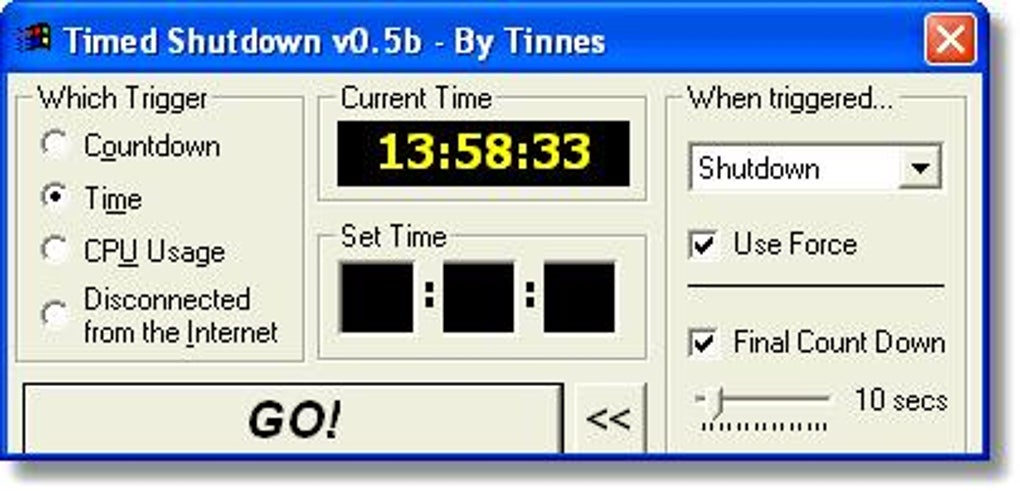

The -t parameter allows you to set a specific length of time before the system begins the shutdown process, defined in seconds.
SHUTDOWN TIMER BATCH FILE FULL
Shutdown -s -t: The shutdown command tells Windows you want to shutdown, while -s confirms it is a full shutdown (rather than a restart or entering hibernation mode).The additional /mir parameter makes sure that every folder and subfolder copies, too. Robocopy /MIR: You've already taken robocopy for a spin.The additional batch file commands used here are:

Save the batch file, remembering to switch the file extension to. In a new text file, input the following commands: Robocopy "C:\your\folder" "X:\your\backup\folder" /MIR It involves creating a backup of a folder to an external drive, then shutting the computer down on completion. The final batch file backup automation script is super simple. You can backup the entire folder using the following command, assuming you're using the same "set drive" and "set backupcmd." %backupcmd% "%USERPROFILE%" "%drive%\%UserName% - profile" You might note that the folders comprise different parts of your Windows user profile. The batch file includes several folders to copy. Now, if you want to add more backup locations to the batch file, use the following command: %backupcmd% ".source directory." "%drive%\.destination dir." /y suppresses prompts confirming you want to overwrite read only files./i if destination doesn't exist, and you're copying more than one file, /i assumes the destination must be a directory./c carries out the command specified by the string, then terminates.Following the xcopy command is a string of parameters that include extra tasks: The next command sets the specific backup copy type your batch file will use, in this case, xcopy. In the example, the drive is set to "X." You should change this letter to whatever your external backup drive letter is. Regedit /e "%drive%\Registry\regbackup.reg"Įcho Backup an explanation as to what the commands in this batch file mean and the bits you can customize.įirst, set the location you want to copy the files to using set drive=X:\Backup. If exist "%drive%\Registry\regbackup.reg" del "%drive%\Registry\regbackup.reg" If not exist "%drive%\Registry" mkdir "%drive%\Registry" %backupcmd% "%USERPROFILE%\Local Settings\Application Data\Microsoft\Outlook" "%drive%\Outlook" %backupcmd% "%USERPROFILE%\Local Settings\Application Data\Identities" "%drive%\Outlook Express"Įcho # Backing up email and contacts (MS Outlook). %backupcmd% "%USERPROFILE%\Application Data\Microsoft\Address Book" "%drive%\Address Book" %backupcmd% "%USERPROFILE%\Favorites" "%drive%\Favorites"Įcho # Backing up email and address book. %backupcmd% "%USERPROFILE%\My Documents" "%drive%\My Documents" Set backupcmd=xcopy /s /c /d /e /h /i /r /y This time you will build a longer string of folders to backup, including your system registry and other important folders. The easy backup method works best for backing up individual folders, but isn't entirely practical for anything more complex. Now, head to File > Save As, name the file systembackup.bat, and complete the Save. ROBOCOPY C:\your\filename\goes\here C:\your\backup\location\goes\here /LOG:backuplog.txt Open Notepad, then input the following commands: echo off Sometimes, it pays to make a couple of copies of anything that might make you cry if it were deleted or destroyed. You should use system backup and system restore points as part of your regular system maintenance. You can use a batch file to backup a specific folder or as part of a more substantial backup setup. Automate System Backup Using a Batch File /c del is the delete aspect of the commandģ.Increase or decrease depending on your requirements We used the wildcard operator "*" in our first example, and specified. /m instructs the command to use the given search mask./s instructs the command to search sub-directories.

the directory you want to delete the files from


 0 kommentar(er)
0 kommentar(er)
